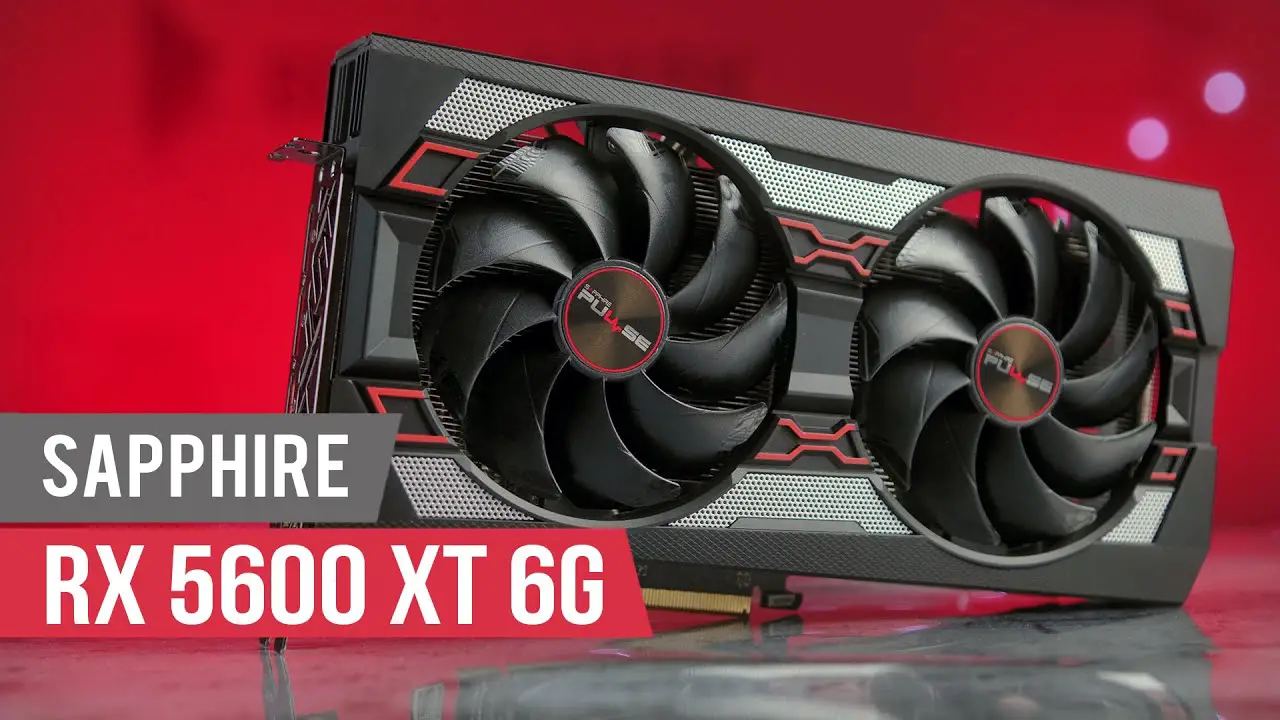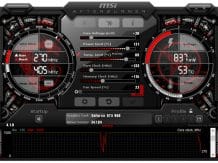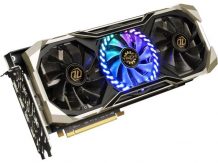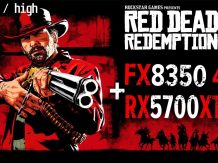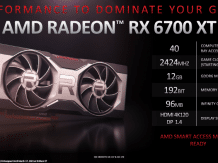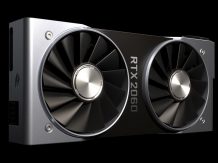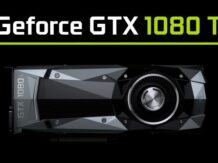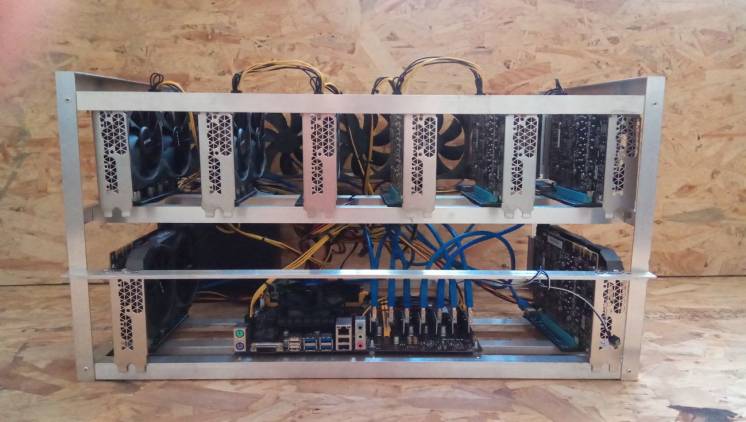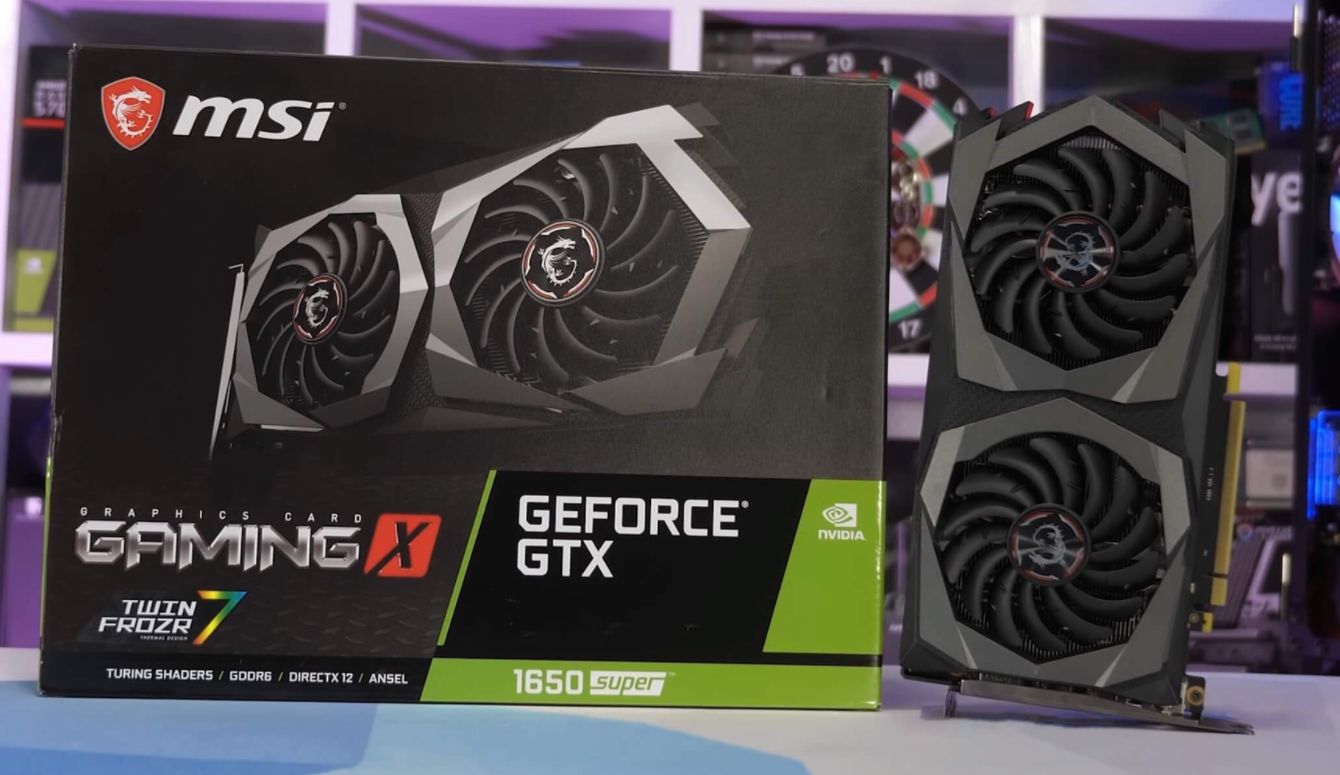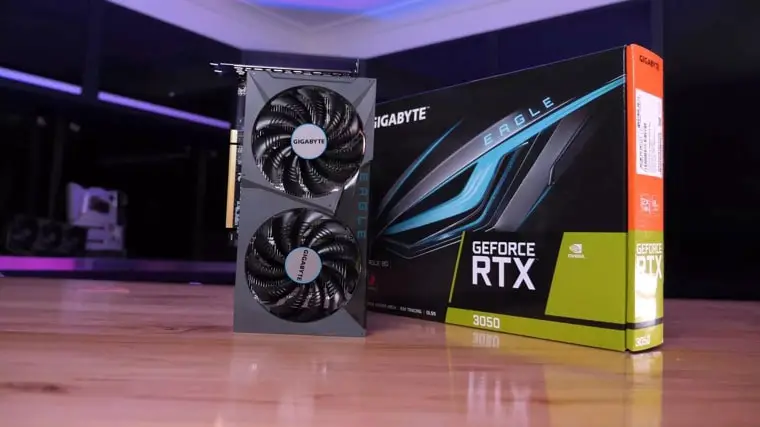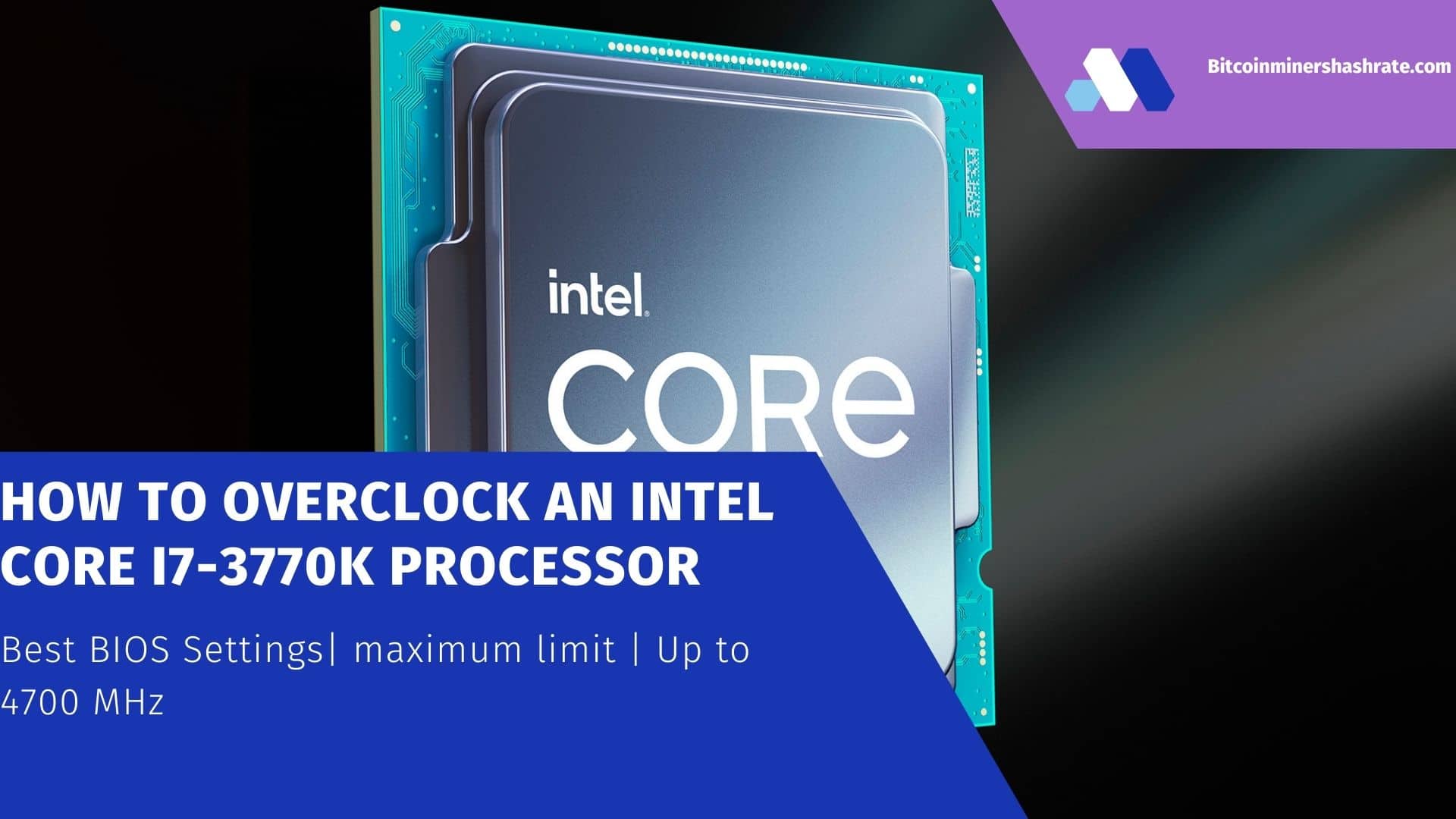How to ‘increase/ Max/ Optimize/ Boost’ SAPPHIRE PULSE RX 5600 XT 6G Gaming: Overclocking | Bios | Hashrate | Boost Clock – On January 7th at CES 2020, AMD announced another NAVI generation graphics card called the Radeon RX 5600 XT. The first thing that catches your eye is the greatly reduced memory subsystem compared to the RX5700: 6Gb of video memory instead of 8Gb and 192-bit data bus instead of 256 bits, as well as the use of slower GDDR6 memory. Which reduces the bandwidth of the memory channel. With the introduction of the Radeon RX 5600 XT, AMD plans to bring higher performance to the market at 1080p – at least that’s the goal of the new product, and the Radeon RX 5600 XT should fill this performance gap between the RX5700 and RX5500 XT.
As it turned out, AMD did not prepare a separate GPU for the Radeon RX 5600 XT, which would match the speed of the TU116 from NVIDIA, serving the entire GeForce GTX 1660 series, therefore, in order to compete with the TU116, the basis of the Radeon RX 5600 XT is Navi 10, which is made according to this same 7 n. m. process technology as well as Navi 14.
How to OVERCLOCK and UNDERVOLT RX 5600XT | ADRENALIN Easy Guide, Tutorial
The Navi 10 chip in the Radeon RX 5600 XT not only retained most of the processing power of the full-featured version, but also fully reproduces the configuration of the Radeon RX 5700, including 36 Compute Units (2304 stream processors) and 64 blocks of operations rasterization (ROP), however, differs from the Radeon RX 5700 in lower clock speeds and truncated memory connection. In the initial version, the base frequency of the GPU is set at 1130 MHz, the Game Clock level is 1375 MHz, and the maximum acceleration (Boost Clock) – 1560 MHz. In this case, the peak theoretical performance when working with single precision numbers is about 7.19 TFLOPs, instead of 7.95 TFLOPs in the reference Radeon RX 5700.
Together with the computing units, the memory bus was also cut off in the Radeon RX 5600 XT – only three of the four 64-bit memory channels remained active. Although 64 ROPs remained, the memory bus eventually became only 192-bit. However, support for fast GDDR6 memory allowed us to achieve decent bandwidth. If we talk about the power consumption of the entire Radeon RX 5600 XT board, then according to the specifications it is 150 W (or 160 W for some versions), and to deliver the necessary power, in addition to the PCI Express slot, one additional 8-pin and one 6-pin power connectors, but this set may differ in different solutions from company partners.
How to increase RX 5600 XT 6G Gaming: Specifications
| CPU |
| Navi 10 XLE (RDNA) |
| Technical process |
| 7 p.m. |
| GPU frequency |
| 1130 – 1375 – 1560 MHz |
| Stream Processors (Shading Units) |
| 2304 |
| Texture Units (TMUs) |
| 144 |
| Raster Operations Pipelines (ROPs) |
| 64 |
| Memory type |
| GDDR6 |
| Memory bus width |
| 192 pages |
| Memory |
| 6 GB |
| Memory frequency |
| 1500MHz (12000MHz) |
| Memory bandwidth |
| 288 GB / s |
| Power consumption (TDP) |
| 150 watts |
| Price |
| — |
Next, let’s go directly to the participants in our testing, there will be four of them today: Sapphire Pulse Radeon RX 5600 XT; MSI RX 5600 XT Gaming Z; Gigabyte Radeon RX 5600 XT Gaming OC; ASUS ROG STRIX RX 5600 XT.
Introducing the AMD Radeon RX 5600 XT. Review of the ASUS ROG-STRIX-RX5600XT-O6G-GAMING video card
After the successful launch of the Radeon RX 5700 and Radeon RX 5500 XT graphics adapters, AMD had an empty niche to fill with new products. This role was taken over by the Radeon RX 5600 XT graphics card, offering good performance at an affordable price. She managed to start with some characteristics, but after launching on the market, many manufacturers released BIOS with increased frequencies. We will try to understand all these nuances in this review, evaluating the potential of different versions of the Radeon RX 5600 XT using the example of the ASUS ROG Strix video card.
At the heart of the new graphics card is the Navi 10 GPU based on the RDNA architecture. This GPU was previously the basis for the Radeon RX 5700 and RX 5700 XT. That is, instead of developing a new chip, AMD chose the simple path of cutting back the older processor. The full version of Navi 10 has 40 active Compute Units and 2560 ALUs for the entire chip. The Radeon RX 5600 XT has four CUs disabled and one memory controller with accompanying cache. As a result, the budget version of Navi 10 has 2304 streaming ALUs, 144 texture units and 64 rasterization units. The memory bus has been cut from 256 to 192 bits, and the memory size has been reduced from 8 to 6 GB. This is an unusual combination for AMD solutions, but NVIDIA has long been producing video cards on a 192-bit bus with 6 GB of video buffer.
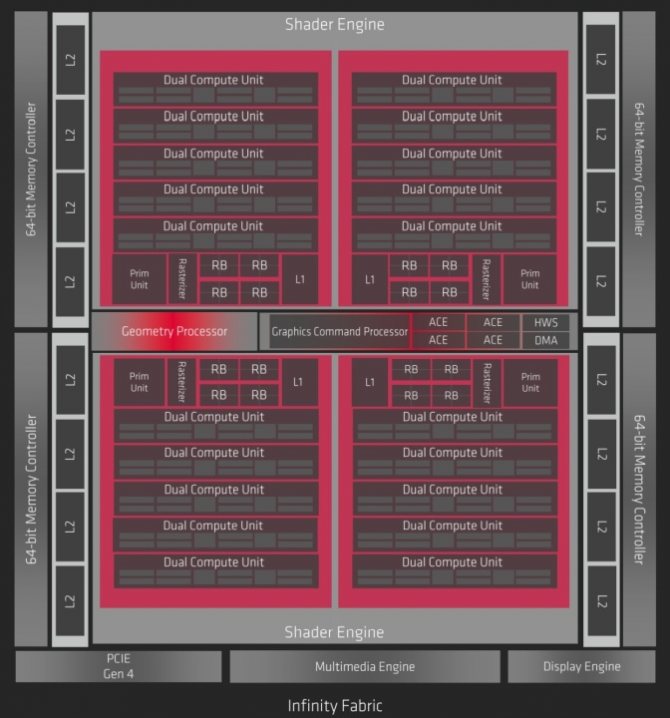
Navi GPU 10
A small cut in active blocks can be estimated as a decrease in the potential of the chip by 11%. But this is combined with lower operating frequencies and tighter power limits. Initially, the Radeon RX 5600 XT claims a base core of 1130 MHz with a Boost Clock of 1560 MHz and a Game Clock of 1375 MHz. The decrease in memory bandwidth due to the trimmed bus is compensated by the use of high-speed GDDR6 chips with an effective data exchange rate of 12 GHz. And 6 GB of memory is enough for modern games in massive Full HD resolution (with rare exceptions).
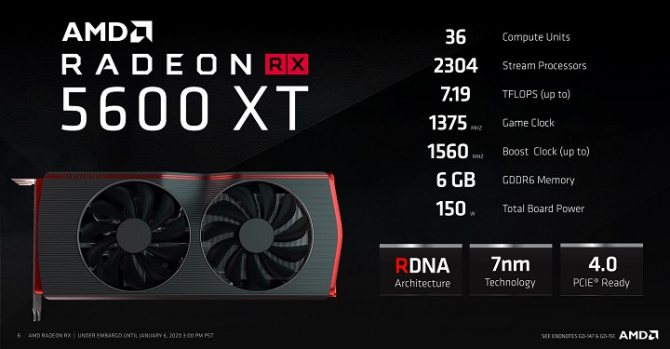
Frequency characteristics require a separate explanation. At the moment, all modern video cards use Boost technology, adjusting the operating frequencies to the specified power and temperature limits. Previously, AMD indicated only a certain average Boost value, in the models of the new series there was also a Game Clock value, which more accurately reflects the average frequency level under a gaming load. And all this does not apply to the peak values of Boost, which are not indicated in the specifications at all, but we usually mention them in reviews.
In the case of the Radeon RX 5600 XT, everything turned out to be more confusing due to the fact that the frequency formula of 1130/1375/1560 MHz was originally declared, but at the time of launch, many manufacturers presented updated BIOS with increased frequencies. However, this upgrade is not a final overhaul of the characteristics of the Radeon RX 5600 XT. Initially, the declared frequencies are the official specifications of AMD, but, most likely, they will be relevant only for the cheapest models of the new series. All top-end versions of Radeon RX 5600 XT with factory overclocking have de facto accelerated firmware. At the same time, the final frequencies for different video cards may differ slightly. Memory frequencies may differ depending on the firmware. A number of models have GDDR6 memory accelerated up to 14 GHz, but some versions retained frequencies at 12 GHz even when GPU accelerated. An important point is the increase in power in the updated versions. If initially a TDP of 150 W was declared for the Radeon RX 5600 XT, then for the variants with the new BIOS it is 160 W.
| Video adapter | Radeon RX 5700 | Radeon RX 5600 XT | Radeon RX 5500 XT |
| Core | Navi 10 | Navi 10 | Navi 14 |
| Number of transistors, mln.pcs | 10300 | 10300 | 6400 |
| Process technology, nm | 7 | 7 | 7 |
| Core area, sq. mm | 251 | 251 | 158 |
| Number of stream processors | 2304 | 2304 | 1408 |
| Number of texture units | 144 | 144 | 88 |
| Number of rendering units | 64 | 64 | 32 |
| Core base frequency, MHz | 1465 | 1130 | 1607 |
| Game Clock, МГц | 1625 | 1375 | 1717 |
| Boost Clock, Мгц | 1725 | 1560 | 1845 |
| Memory bus, bit | 256 | 192 | 128 |
| Memory type | GDDR6 | GDDR6 | GDDR6 |
| Memory frequency, MHz | 14000 | 12000 | 14000 |
| Memory capacity, GB | 8 | 6 | 8/4 |
| Supported DirectX Version | 12 (12_1) | 12 (12_1) | 12 (12_1) |
| Interface | PCI-E 4.0 (16x) | PCI-E 4.0 (16x) | PCI-E 4.0 (8x) |
| Power, W | 180 | 150 | 130 |
The Radeon RX 5600 XT can potentially catch up with the older version due to overclocking, but AMD strictly limited the maximum frequencies, limiting the overclocking limits. Therefore, the standard overclocking is small, but you can still squeeze it out by unlocking the limits in the MorePowerTool utility.
In our review, we will test a graphics card with frequencies that are close to the initial specifications, with an updated BIOS that allows for higher GPU and GDDR6 memory frequencies, and with additional overclocking.
ASUS ROG-STRIX-RX5600XT-O6G-GAMING
We got our hands on the ASUS ROG Strix Radeon RX 5600 XT video card. It comes in a large box with a colorful design.
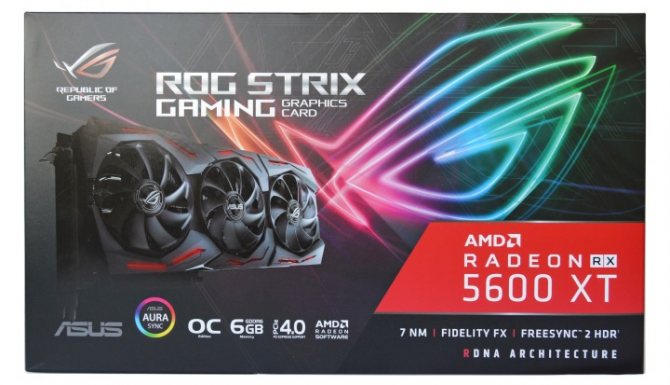
In addition to the standard instructions, the package includes a set of Velcro ties for fixing the cables.
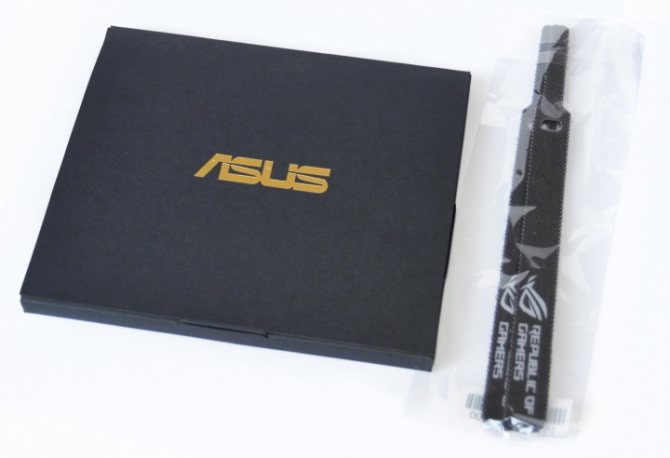
Designed with the unmistakable style of ROG Strix. Before us is a massive large card with a large cooler and three new-type fans with a rim on the edges. The graphics adapter does not resemble a budget video card, but looks like a full-fledged product of the highest price segment. The manufacturer clearly did not save on the ROG Strix Radeon RX 5600 XT, which certainly pleases.
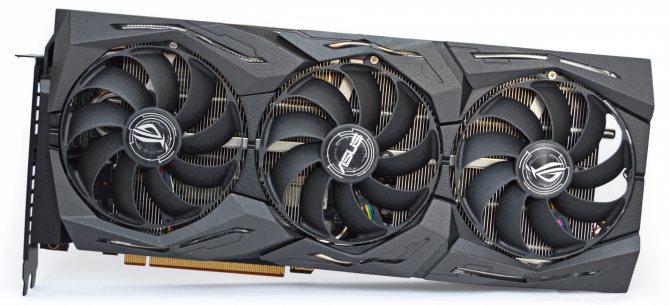
The thickness of the video card reaches 2.7 slots. Full length 30.5 cm.
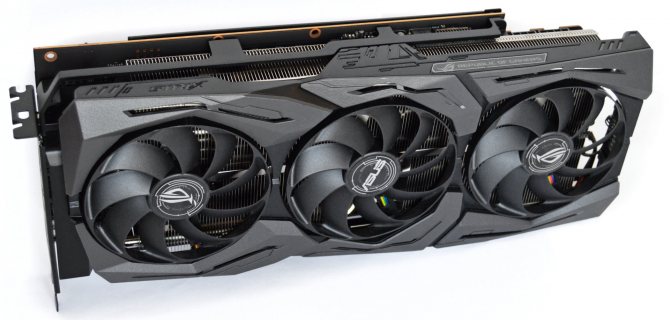
The reverse side is covered with a metal plate.
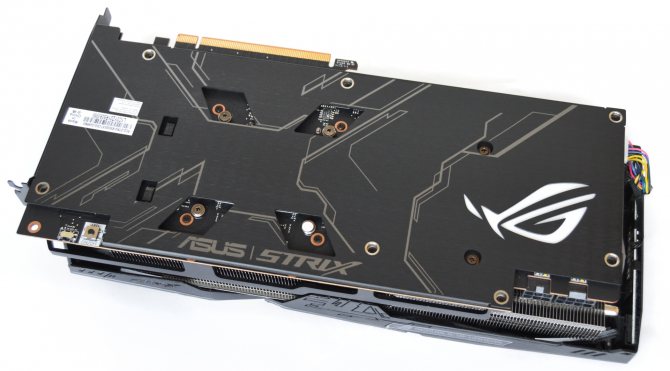
There is an open area in the opposite corner. It contains a button to manually turn off the backlight and a BIOS switch. ASUS has two firmwares. One offers a factory overclocked Performance mode, the other offers a quieter Quiet fan control algorithm with a slight power limitation.
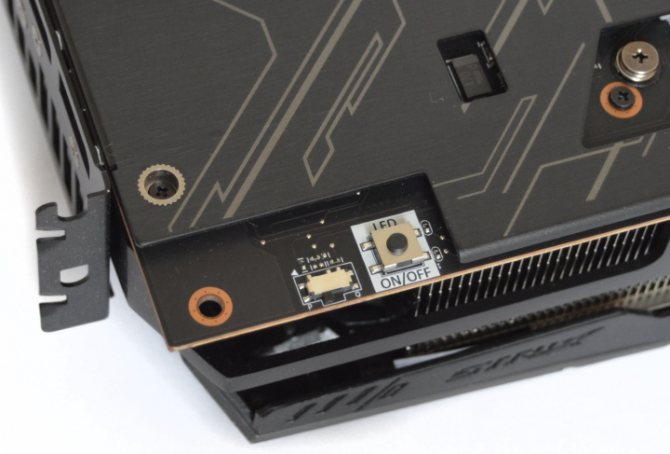
There are two power connectors in the corner: six and eight pins.
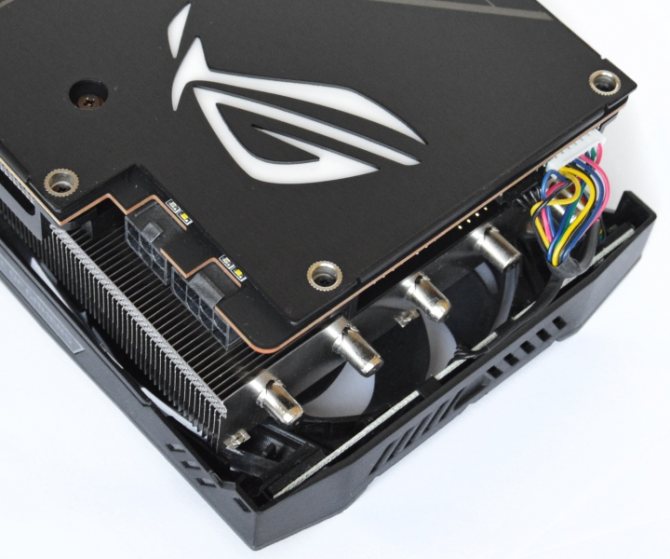
If you are a backlight lover, then ASUS ROG Strix will delight you. The backlight is provided for the large logo on the plate, there are also luminous inserts around the fans. There is an opportunity to select different lighting effects and glow modes through the corresponding utility Aura Sync.
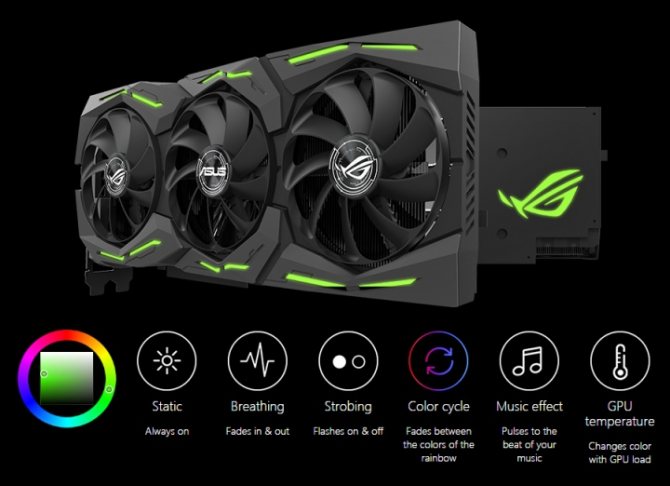
Let’s take a look at the cooling system. It looks very serious, because it is a full-fledged cooler from older video cards – six heat pipes, a large heatsink with many fins and a flat base. A single design removes heat from the graphics chip and from the VRM elements.
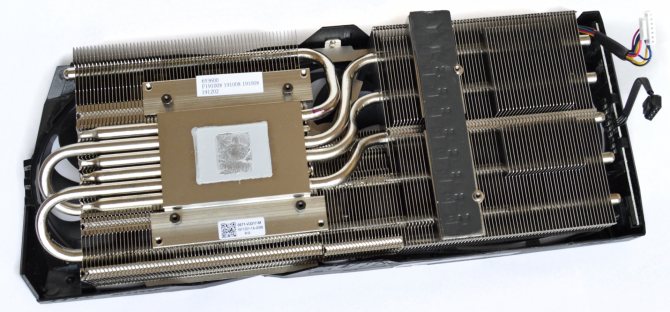
The current Strix models use a smooth, ground base to dissipate heat away from the chip, which ensures a perfect fit. And the heat pipes are laid in grooves carefully fitted for them. Everything is done perfectly smoothly and without gaps. And all elements of the cooler are nickel-plated.
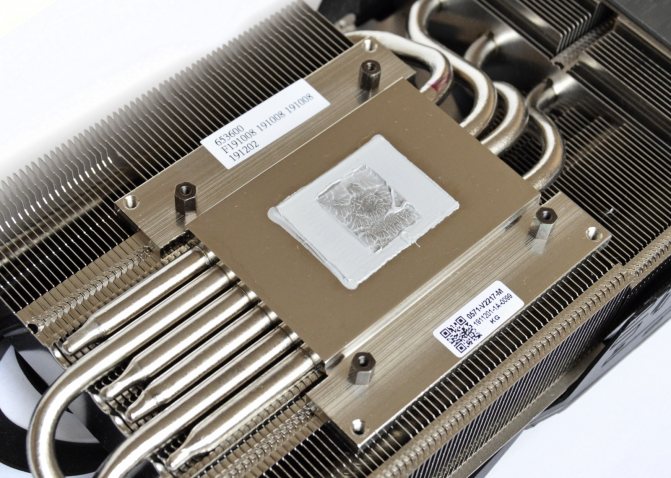
Three specially designed fans are installed on top of the radiator. The Axial-tech design, with a small hub, wide blades and rim at the edges, provides more airflow for better radiator airflow.
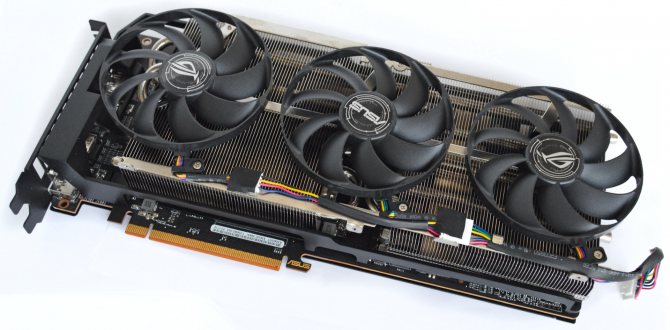
The board is covered with a large massive heatsink plate that removes heat from memory chips and some power elements.
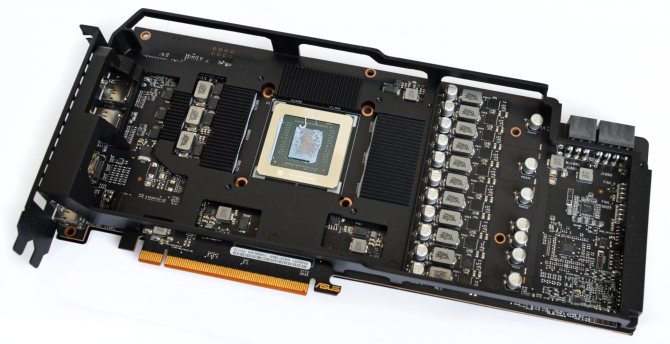
The plate on the back is also involved in cooling thanks to the large thermal pads under the graphics memory chip. The plate has additional metal strips in the contact area.
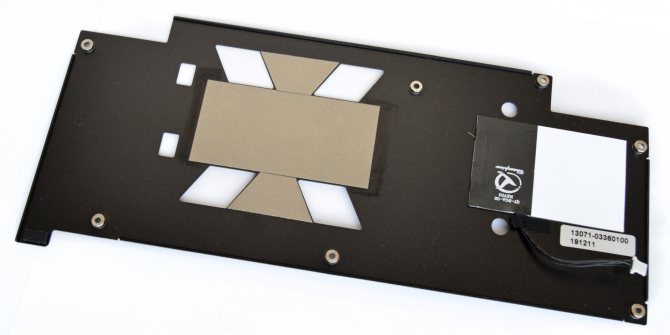
The ASUS graphics card uses a large PCB of its own design from the RX 5700 series. It is manufactured using Auto-Extreme technology, which provides for automated wiring of all elements in one pass to avoid unnecessary thermal effects. We also use high quality electronic components that meet the internal Super Alloy Power II standard.
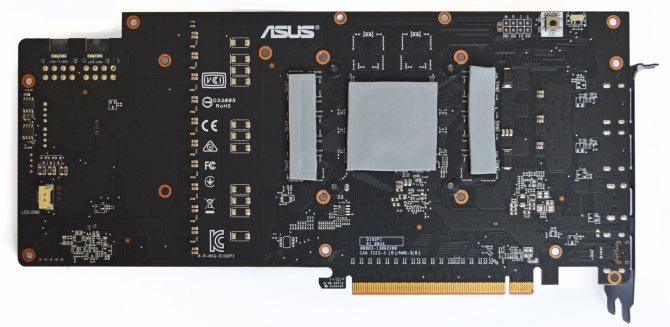
The board has 14 power phases, which not even all Radeon RX 5700 models have.
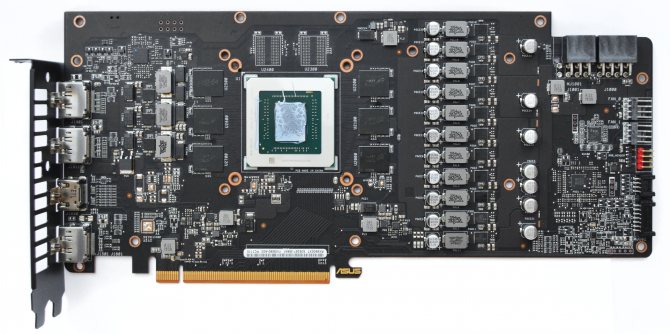
On the right side of the board is the 11-phase GPU power supply system.
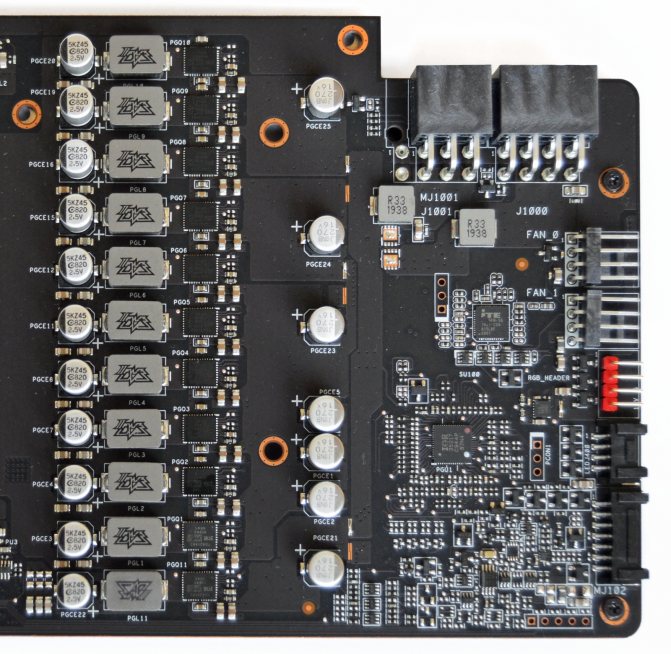
The Navi 10 processor is made according to the 7nm process technology. It has 10.3 billion transistors, occupying an area of 251 mm².
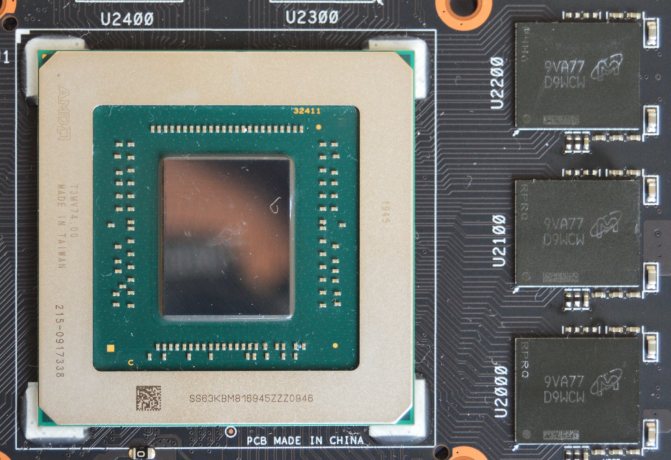
Initially, for the ROG-STRIX-RX5600XT-O6G-GAMING core frequencies of 1560/1620 MHz (Game / Boost Clock) were provided, which is already higher than the standard level. With this firmware, the video card ended up in our laboratory.
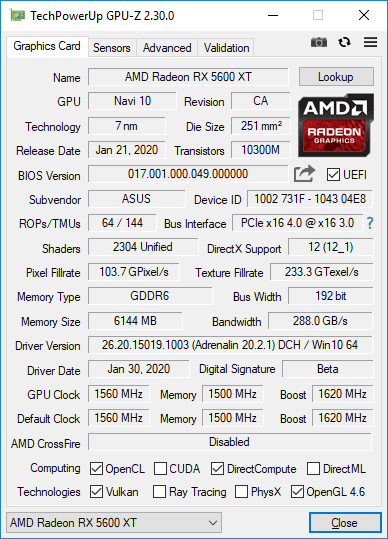
Then we flashed the new BIOS provided by the developer. He raised the frequencies to 1670/1750 MHz. At the same time, the memory frequency was increased to 14 GHz, although 12 GHz is still listed on the official ASUS website. It is possible that the accelerated versions of ROG-STRIX-RX5600XT-O6G-GAMING come to the mass market with 12 GHz memory.
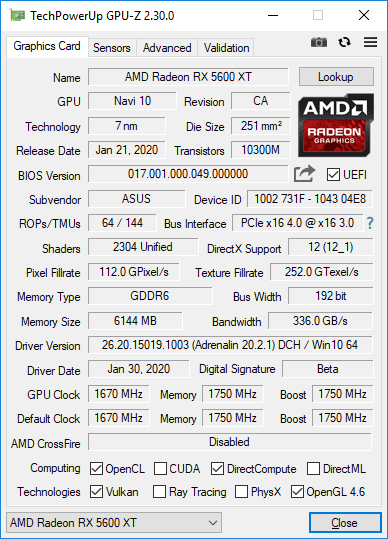
We used both firmwares for testing, because we need to assess the potential of the cheapest versions of the Radeon RX 5600 XT and accelerated options with factory overclocking. In the first case, the Quiet mode is enabled on the old BIOS. In it, the maximum Boost limit is set at 1650 MHz, and the real frequencies in games varied in the 1570-1590 MHz range. And judging by other reviews, this is close to the frequency characteristics of simple video cards of the new series. Noise and heating in this mode is minimal. On an open bench (in a room of 23 ° C), after the start of applications, the fans gradually stabilized at a speed of less than 1000 rpm, and the peak core temperatures did not exceed 58 ° C.
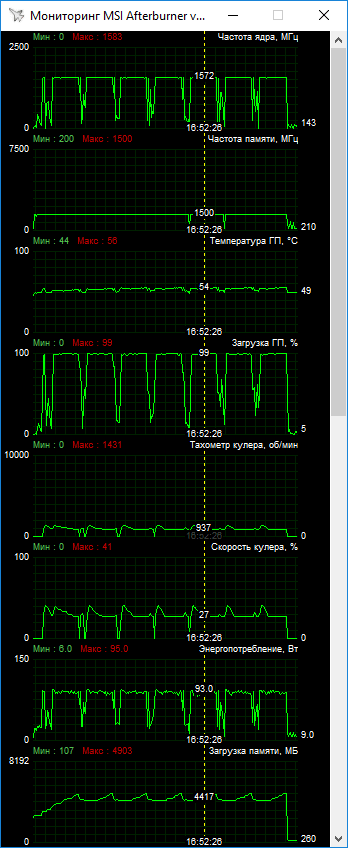
With the updated BIOS, the core frequencies immediately increased to 1700 MHz (peak value of 1780 MHz), dropping below only in the most difficult applications or at high resolutions. Along the way, the memory frequency has increased (the final value is 14 GHz). The frequency dynamics of the new BIOS is reflected in the bottom screenshots of monitoring parameters during prolonged load in Final Fantasy XV and The Division 2 at Full HD resolution. As the resolution increases, the frequencies decrease slightly.
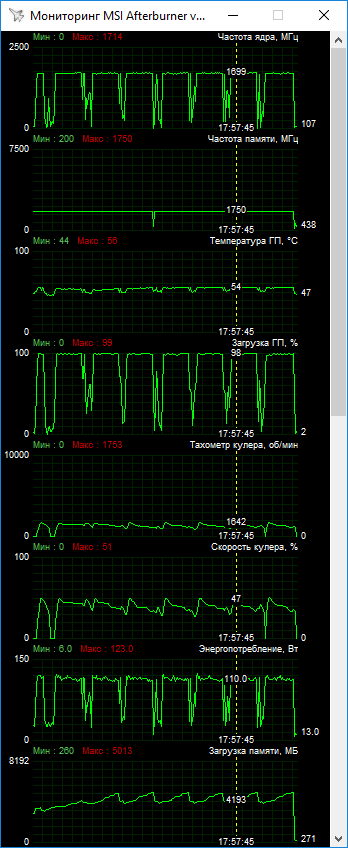
The fan speed was 1300–1700 rpm. And with its smooth change, it is really quiet and imperceptible against the general background of a working PC. Peak core temperatures did not exceed 59 ° C. Inside the case, the heating may be higher, but a change in temperature by several degrees is not at all critical. These are excellent temperature and noise indicators that will suit the most demanding user.
The video card was overclocked with a new BIOS, which initially had an increased power limit, and additional settings allow you to raise it by another 20%. All operations were performed through standard overclocking tools in the AMD Control Center menu. As mentioned above, the Radeon RX 5600 XT has overclocking limits. The core can be accelerated by only 2%, which, combined with an increase in the power limit, can give a greater increase, but without the ability to reach the frequencies of older video cards. With an initial memory frequency of 14000 MHz, its overclocking is limited to 14880 MHz. Along the way, we slightly lowered the voltage relative to the automatic value set during overclocking – this feature is available only for the maximum Boost point without smooth settings of the frequency curve.
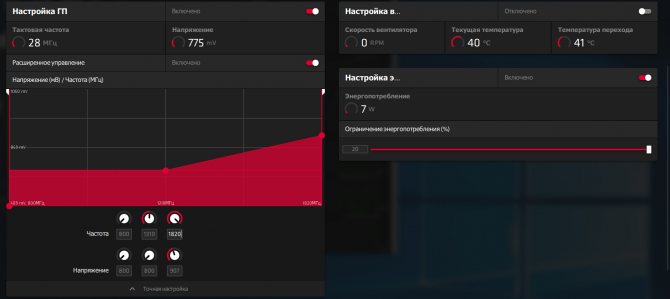
With these settings, the average Boost frequencies in games increased to 1740-1760 MHz. That is, the overall growth is strictly at the level of 2%. Overclocking memory provides a 6% increase in bandwidth. As for the noise, we left the fans working in automatic mode, slightly increasing the value of the maximum speed. Operating temperatures remained unchanged at speeds ranging from 1400 rpm to 1800 rpm at peak times. That is, the video card remained quiet and cold.
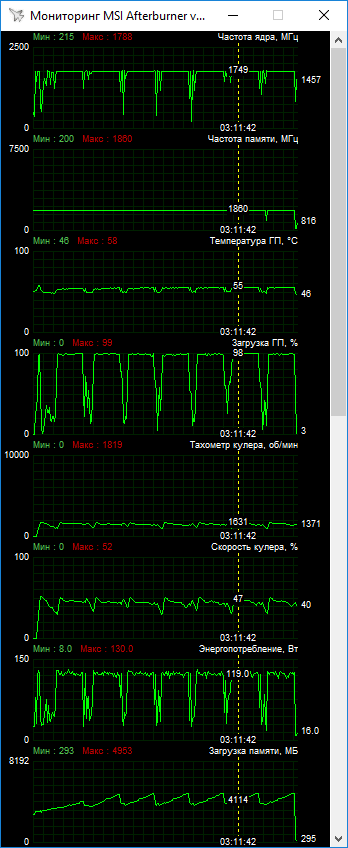
To squeeze more out of the Radeon RX 5600 XT, you can use the MorePowerTool utility. But in this review we will restrict ourselves to standard overclocking.
Radeon RX 5500 XT : Characteristics of the tested video cards
Let’s test the Radeon RX 5600 XT in three modes at different frequencies. Let’s compare it with the old AMD flagship Radeon RX Vega 64 and the younger models of the current generation – Radeon RX 5500 XT and GeForce GTX 1650 Super.
| Video adapter | Radeon RX Vega 64 | ASUS ROG Strix RX 5600 XT | Radeon RX 5600 XT | Radeon RX 5500 XT 8GB | GeForce GTX 1660 Super |
| Core | Vega 10 | Navi 10 | Navi 10 | Navi 14 | TU116 |
| Number of transistors, mln.pcs | 12500 | 10300 | 10300 | 6400 | 6600 |
| Process technology, nm | 14 | 7 | 7 | 7 | 12 |
| Core area, sq. mm | 486 | 251 | 251 | 158 | 284 |
| Number of stream processors | 4096 | 2304 | 2304 | 1408 | 1408 |
| Number of texture units | 256 | 144 | 144 | 88 | 88 |
| Number of rendering units | 64 | 36 | 36 | 32 | 48 |
| Core frequency (Base-Boost), MHz | 1274–1546 | Until 1750 | 1130–1560 | 1607–1845 | 1530–1785 |
| Memory bus, bit | 2048 | 192 | 192 | 128 | 192 |
| Memory type | HBM2 | GDDR6 | GDDR6 | GDDR6 | GDDR6 |
| Memory frequency, MHz | 1890 | 14000 | 12000 | 14000 | 14000 |
| Memory capacity, GB | 8 | 6 | 6 | 8 | 6 |
| Supported DirectX Version | 12 | 12 (12_1) | 12 (12_1) | 12 (12_1) | 12 (12_1) |
| Interface | PCI-E 3.0 | PCI-E 4.0 | PCI-E 4.0 | PCI-E 4.0 (8x) | PCI-E 3.0 |
| Power, W | 295 | 160 | 150 | 130 | 125 |
The table shows the official data on Boost frequencies. Further, the graphs show the full range of GPU frequencies, where, in addition to the base value, the peak Boost is shown, which is higher than the declared Boost Clock. In the case of ASUS Radeon RX 5600 XT, there is an uncertainty about the base value, since it is not specified anywhere. Therefore, for ASUS, Game Clock frequencies are indicated as the starting point.
How to Optimize: Test stand
The test bench configuration was as follows:
- processor: Intel Core i7-6950X (3, [email protected], 2 GHz);
- cooler: Noctua NH-D15 (two NF-A15 PWM fans, 140 mm, 1300 rpm);
- motherboard: MSI X99S MPower;
- memory: G.Skill F4-3200C14Q-32GTZ (4 × 8 GB, DDR4-3200, CL14-14-14-35);
- system drive: Kingston SSDNow KC400 (512 GB, SATA 6Gb / s);
- additional disk: WD Red 3TB WD30EFRX (3 TB, SATA 6Gb / s, 5400 rpm);
- power supply: Raidmax Cobra RX-800AE;
- monitor: ASUS PB278Q (2560×1440, 27 ″);
- operating system: Windows 10 Pro x64;
- драйвер Radeon RX 5500 XT: AMD Adrenalin Edition 20.1.1;
- Radeon driver: AMD Adrenalin Edition 20.2.1 / 20.1.1;
- GeForce driver: NVIDIA GeForce 442.01 / 441.66.
Testing was carried out using this method at a resolution of 1920 × 1080. The graphs show the minimum and average fps.
Test results
A Plague Tale: Innocence
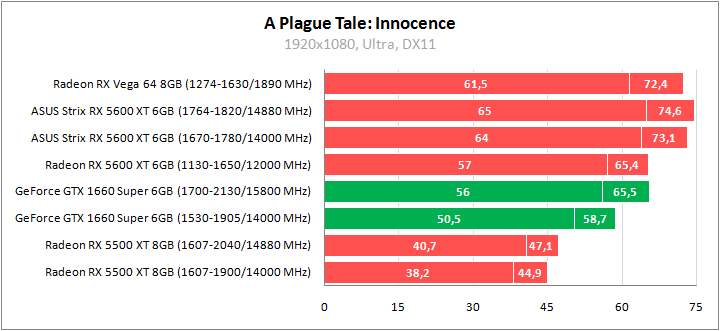
The Radeon RX 5600 XT performs well in the tough A Plague Tale. ASUS with the new BIOS is 11% faster than the regular version, overtaking the old flagship Radeon RX Vega 64.
Assassin’s Creed Odyssey
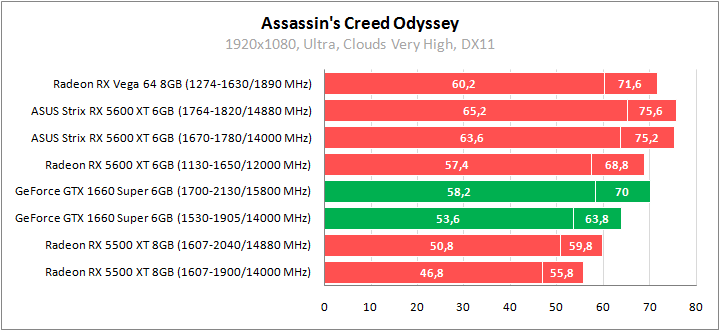
At standard frequencies, the Radeon RX 5600 XT shows performance at the level of the overclocked GeForce GTX 1660 Super, inferior to the minimum to the Radeon RX Vega 64. The new BIOS provides 10% acceleration, additional overclocking gives less noticeable gains.
Battlefield V
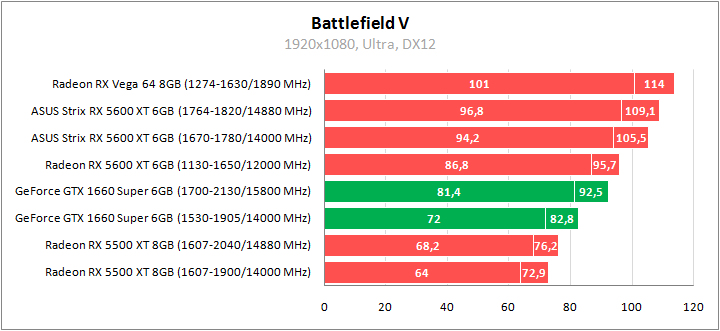
At low frequencies, the Radeon RX 5600 XT is faster than the accelerated GeForce GTX 1660 Super. The lag from the Radeon RX Vega 64 is up to 19%, which is not fully compensated for by overclocking. The new BIOS provides ASUS with the usual acceleration of up to 10%, additional overclocking speeds up another 3%.
Borderlands 3
Borderlands 3 benchmarks were run in two modes, as different graphics cards perform better in different APIs. AMD Radeon has the best DirectX 12 performance (although occasional lags are possible). Even at the initial frequencies, the Radeon RX 5600 XT leaves no chance for the rival NVIDIA, and when overclocked it catches up with the old flagship Radeon RX Vega 64. A detailed analysis of performance in different modes is presented in a separate review.
Control
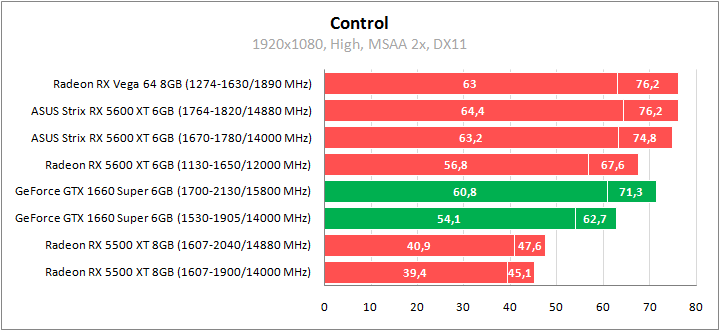
The regular version of the Radeon RX 5600 XT is weaker than the overclocked GeForce GTX 1660 Super in the Control game. But with increasing frequencies, the hero of the review gradually comes out on top, slightly outperforming his older friend AMD.
Detroit: Become Human
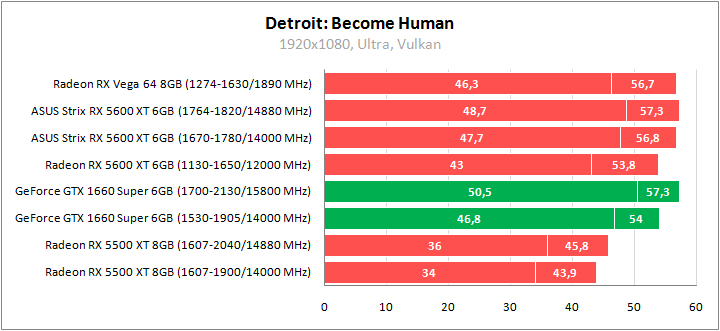
In-game performance is capped at 60 frames, with little difference between participants. At the same time, we can still state the minimal advantage of the GeForce GTX 1660 Super over the Radeon RX 5600 XT, but this will be noticeable only in heavy graphic scenes.
Far Cry 5
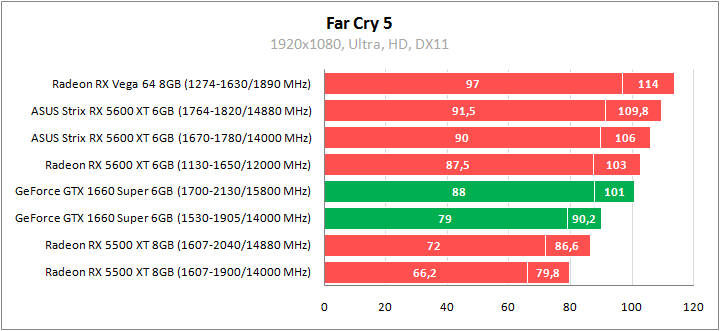
With active HD textures in Far Cry 5, the Radeon RX 5600 XT with low frequencies performs at the level of the accelerated GeForce GTX 1660 Super. At maximum frequencies, ASUS is close to the performance of the Radeon RX Vega 64, but is still behind.
Final Fantasy XV: Windows Edition
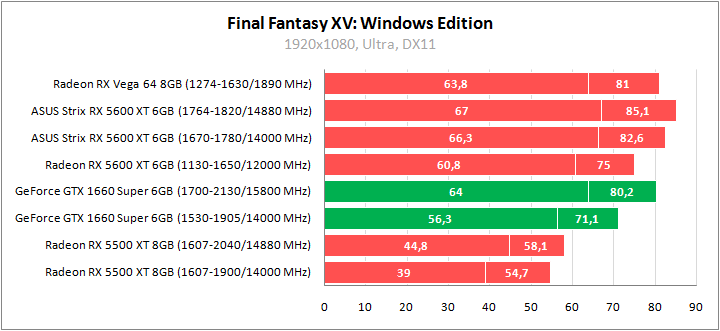
In Final Fantasy XV, the new AMD video adapter is faster than the GeForce GTX 1660 Super at par. With the new BIOS, it is faster than the GeForce GTX 1660 Super in overclocking. Radeon RX Vega 64 scores below ASUS factory clocks.
Gears 5
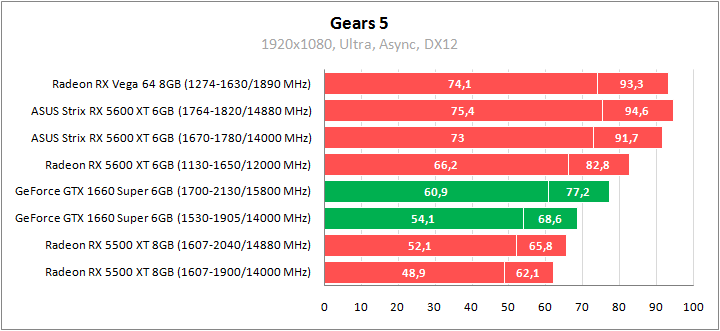
The Radeon RX 5600 XT confidently outperforms the GeForce GTX 1660 Super, and the overclocking compensates for the lag behind its erased comrade AMD. The new BIOS provides acceleration of over 10%, additional overclocking up to 3%. See detailed performance testing in a separate review.
Rage2
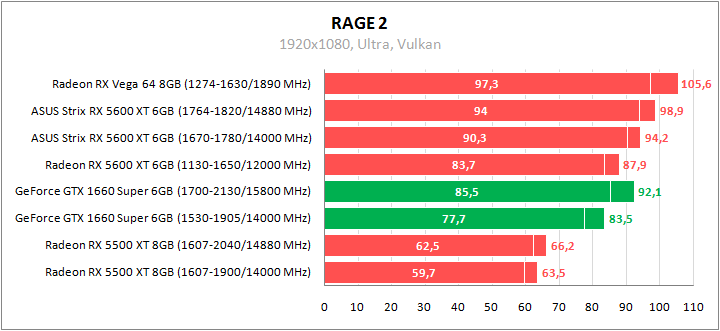
The Radeon RX 5600 XT is faster than the GeForce GTX 1660 Super, but without a major edge. The accelerated contender is faster than the low-clocked newcomer AMD, but the new BIOS pushes the Radeon into higher positions. After overclocking, ASUS reduces the lag behind the Radeon RX Vega 64 to a few percent.
Red Dead Redemption 2
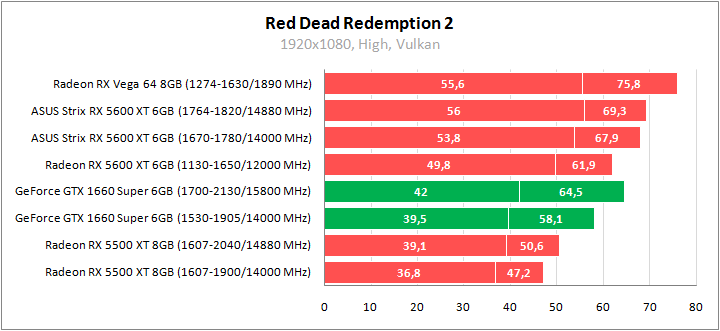
Again, the Radeon RX 5600 XT outperforms the GeForce GTX 1660 Super, and the main advantage here is in the minimum fps. Overclocking minimizes the lag behind the Radeon RX Vega 64.
Resident Evil 2
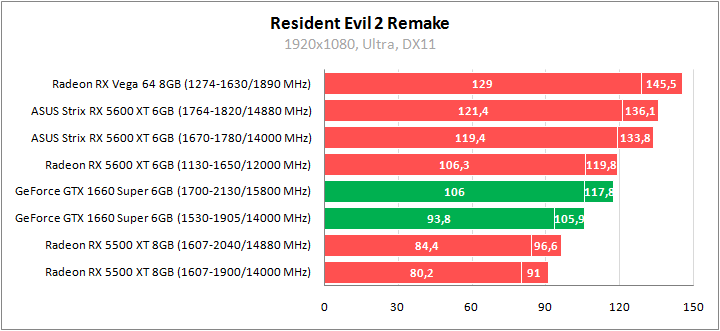
Everything is standard in Resident Evil 2. Radeon RX 5600 XT at minimum frequencies is comparable to the forced GeForce GTX 1660 Super. Overclocking reduces the lag behind its older friend AMD, but the position of the Radeon RX Vega 64 is very strong here.
Shadow of the Tomb Raider
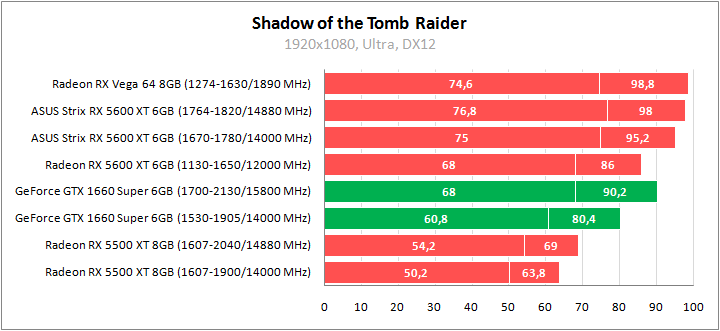
The simple version of the Radeon RX 5600 XT is faster than the GeForce GTX 1660 Super in the nominal value, but also weaker than the accelerated version. ASUS with the new BIOS is faster than the forced competitor and differs minimally from the old AMD flagship.
Star Wars Jedi Fallen Order
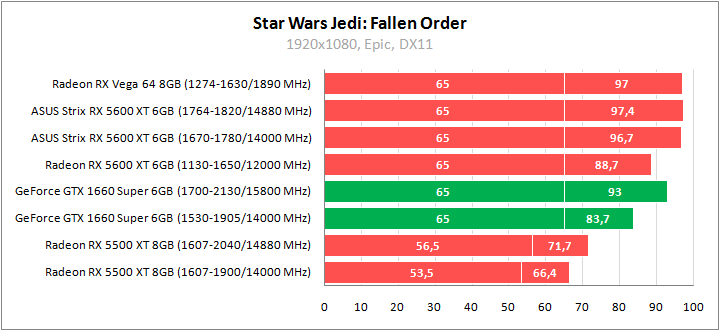
The same minimum fps in Fallen Order indicates that we are running into CPU or other performance limitations. And all the same, the advantage of the Radeon RX 5600 XT over the competitor NVIDIA is noticeable.
The Outer Worlds
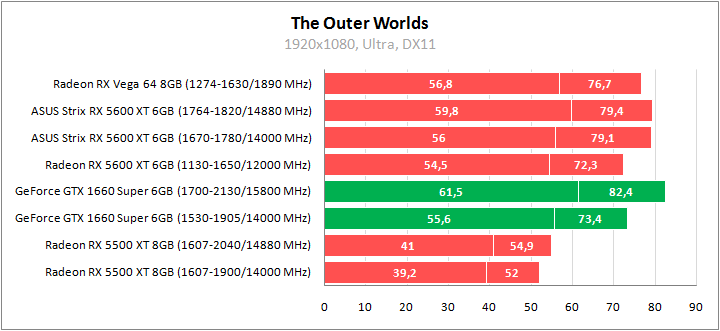
In The Outer Worlds, the hero of the review begins to lose ground a little, giving way to the GeForce GTX 1660 Super. It’s worth noting a slight difference between the newcomer and the Radeon RX Vega 64.
The Witcher 3: Wild Hunt
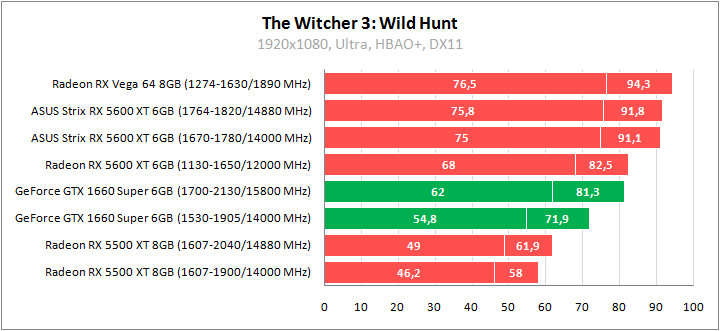
The simplest version of the Radeon RX 5600 XT is better than the overclocked GeForce GTX 1660 Super. ASUS with the new BIOS is faster by another 10%, the benefit from additional overclocking is minimal.
Tom Clancy’s The Division 2
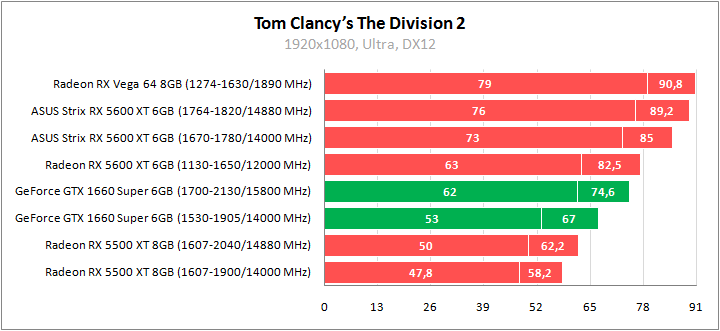
In The Division 2, the Radeon RX 5600 XT looks more powerful than the GeForce GTX 1660 Super, and the overclocking routinely brings it closer to the performance level of the Radeon RX Vega 64.
Total War: Three Kingdoms
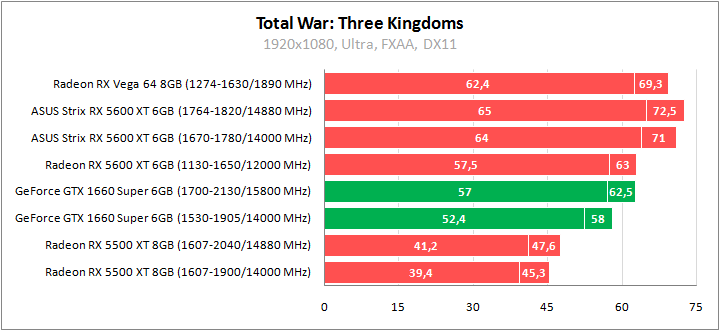
The video adapter Radeon RX 5600 XT with the recommended frequencies is equal to the overclocked GeForce GTX 1660 Super, the new BIOS adds 11-13% performance, allowing it to reach the level of the old AMD flagship.
World of Tanks enCore RT
In normal mode, the Radeon RX 5600 XT looks more powerful than the NVIDIA rival, but after enabling ray tracing, the GeForce GTX 1660 Super comes out on top.
3DMark Time Spy
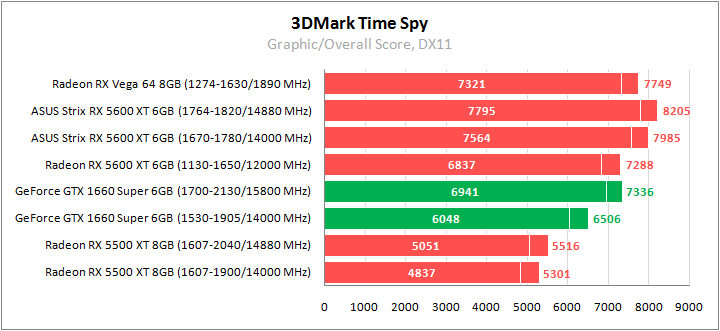
At the initial frequencies, the Radeon RX 5600 XT is 13% faster than the GeForce GTX 1660 Super, showing the result that the competitor achieves in overclocking. The lag behind the Radeon RX Vega 64 is only 7%, which is easily compensated for by raising the frequencies. The new BIOS provides ASUS over 10% acceleration, another 3% can be squeezed out with additional overclocking.
How to Maximize: Energy consumption
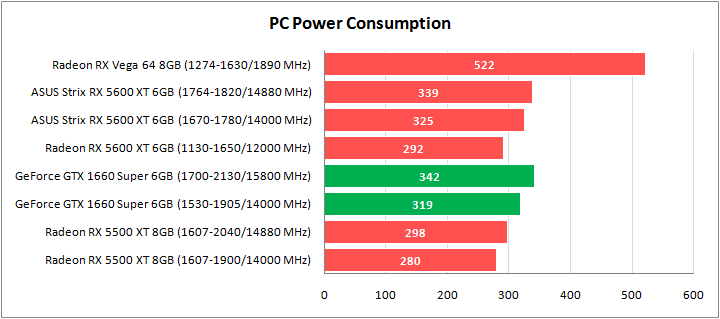
ASUS Radeon RX 5600 XT with old BIOS in Quiet mode shows the highest efficiency. And this despite the fact that a lower TDP is declared for the GeForce GTX 1660 Super! The new BIOS and higher frequencies also increase the power consumption figures, but they are still comparable to the results of the weaker GeForce GTX 1660 Super accelerator.
conclusions
The Radeon RX 5600 XT is a stripped-down version of the Radeon RX 5700 with less memory on a 192-bit bus and lower core frequencies. And even at the initial recommended frequencies, such a video card is faster than the GeForce GTX 1660 Super, which is quite consistent with the price positioning of these products. If we talk about the accelerated versions of the Radeon RX 5600 XT, then they can be 10% faster. The main surprise of the Radeon RX 5600 XT is its low power consumption, which reduces cooling requirements and allows for quieter versions of graphics cards. Of course, it will still depend on each specific model, but in terms of the combination of consumer characteristics, this is a very successful video card in its price niche. It’s also nice to note a slight lag relative to the former flagship Radeon RX Vega 64 against the backdrop of a colossal difference in power consumption.
ASUS ROG Strix Radeon RX 5600 XT graphics card is an excellent representative of the new series. This is a product that is close in all respects to older models – from powerful cooling to high-quality PCB. The video card exhibits excellent thermal and noise characteristics, maintaining low operating temperatures with low noise. Plus backlighting, dual BIOS and other attributes of the top ASUS ROG models. This is one of the video cards whose frequencies were revised immediately after the release, and you may have to flash the BIOS yourself if you want to get a faster version. The new firmware provides 10% acceleration. Further overclocking gives an increase of 2-3%, running into software limitations, because the real potential is even higher. ASUS ROG-STRIX-RX5600XT-O6G-GAMING will be an excellent option to buy,
Test bench configuration
| CPU | Intel Core i7-8700K (6/12; 3,7/4,7 ГГц) | Intel, www.intel.com |
| Motherboard | ASUS ROG X Hero (Intel Z370) | ASUS, www.asus.ua |
| Video card | Palit GeForce RTX 2060 GamingPro OC | Palit, www.palit.com |
| RAM | HyperX Predator RGB DDR4-3600 16 ГБ (HX436C17PB3AK2/16) | HyperX, www.hyperxgaming.com |
| Storage device | Kingston KC2000 1 ТБ (SKC2000M8/1000G) Kingston A1000 480 ГБ (SA1000M8/480G) | HyperX, www.hyperxgaming.com |
| Power Supply | Thermaltake Toughpower Grand TPG-1200M | Thermaltake, www.thermaltakeusa.com |
| Monitor | Acer Predator XB271HK (27″, 3840×2160) | Acer, www.acer.ua |
Thermal photographs
All thermal images were taken under maximum load for a general presentation and understanding of the cooling system with a slight overclocked core and memory.
Having installed the thermal camera on top, we can see that the GPU temperature does not exceed 60 degrees. This is a good indicator.
However, it should be understood that the maximum consumption of the card is only 160 watts, which is actually not that much by modern standards.
Please note that the coolers do an excellent job, the residual heat is dissipated and is not stored inside the card.
Having installed the camera from the back of the video card, where the backplate is located, we can see that the GPU temperature does not exceed 64 degrees . This is also a good result.
GPU measurements are correct, as there is a cutout in the backplate area, in the GPU area.
In work
The video card supports the hybrid mode of operation of the cooling system, stopping the fans at minimum load.
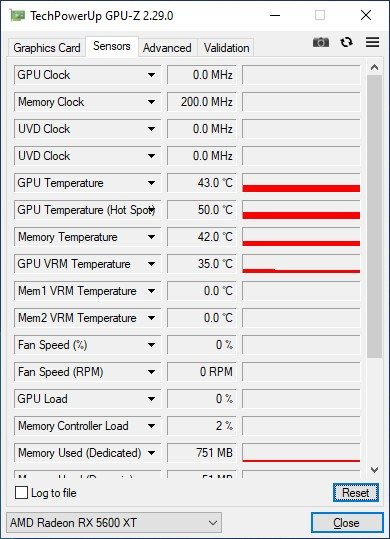
In such conditions, the graphics processor on an open stand warmed up to 44 degrees at 23C indoors.
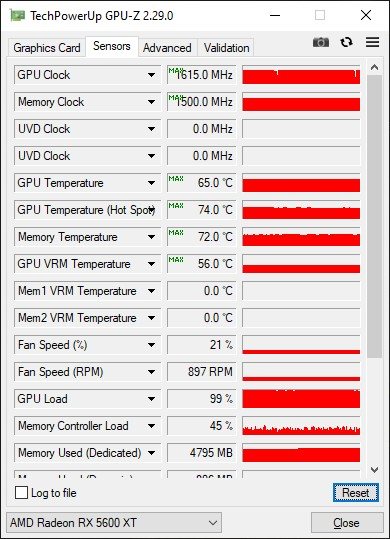
Under gaming load, the GPU warmed up to 64 degrees, while the temperature of the hottest point was 74C. The elements in the power supply stabilizer zone were heated only up to 56C, and the memory chips – up to 72C. During games, the GPU clock speed increased to 1615 MHz.
Gigabyte has already prepared BIOS F2 with forced mode at the start of sales. The official specifications of the video card have not yet been changed on the manufacturer’s website. Therefore, it is possible that the model will be offered with the already indicated combination of chip / memory frequencies, and those who wish can independently update the firmware.
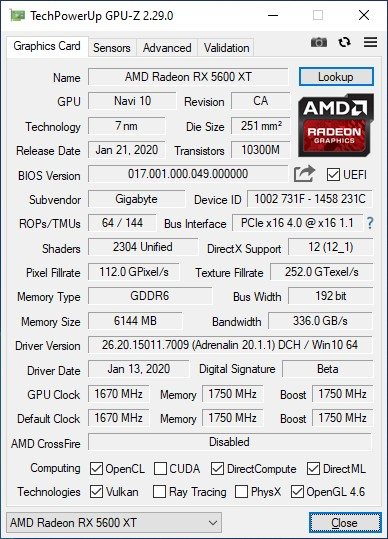
After updating the BIOS, the Game Boost frequency increased to 1670 MHz, and the peak Boost Clock – to 1750 MHz. Moreover, the effective memory frequency has increased from 12000 (1500) to 14000 (1750) MHz. In the description of the BIOS version, the manufacturer focuses on the accompanying increase in the power consumption of the video card. The TGP (Total Graphics Power) parameter has been increased from 150 W to 180 W.
When using this firmware version, the performance of the video card increases by 7-10% on average, but in some projects it was not possible to obtain complete stability. It is obvious that the BIOS will still be refined. The capabilities of the video card platform are sufficient to operate at higher frequencies. Here it is important for the manufacturer to choose the best balance of frequencies / voltages / temperatures / power consumption.





